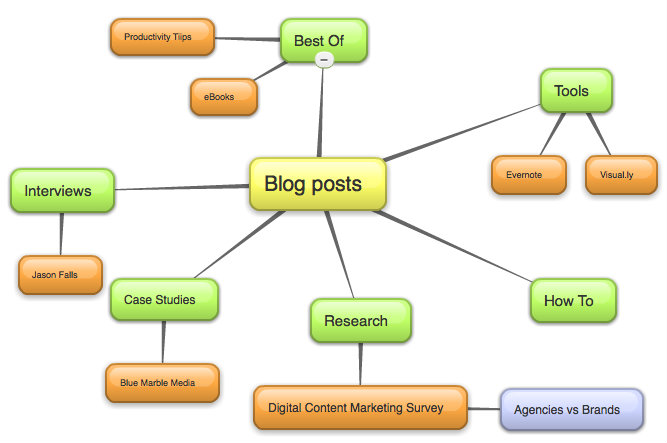Learn how a content mind map can revamp your brand’s content marketing strategy.
Creating quality content for marketing consistently is not easy.
Be it for social media, the company blog, website, email newsletter, podcast or absolutely any other platform or format you’re experimenting with, creating content that is engaging and still adds value to your target audience is becoming more challenging than ever.
But, great ideas and inspiration neither strike on command nor come to us in an organized way.
Even though keywords can be a great way to set guardrails for creating both engaging and value-packed content, marketers often struggle to streamline the process of documenting their ideas and including them strategically in their content marketing plans.
That’s where content mind maps come in.
What is a content mind map?
A content mind map is a visual brainstorming method that uses diagrams with text, lines, arrows, shapes, and symbols to arrange ideas and concepts. Mind mapping is a powerful technique for creating ideas and linking concepts to keep track of one’s chain of thoughts.
Content mind mapping is intuitive and powerful, allowing you to break down even the most challenging topics into more digestible and bite-size information. It is also time effective, enabling you to create impressive topic synopses in minutes.

Mind maps simplify navigating and arranging your content ideas visually without worrying about following a specific pattern. Every mind map will have a central idea or topic at its center. Other thoughts branch out, forming a tree representation of your idea.
For instance, if you want to write an article about “Ultimate Guide to Blogging,” your brain is spinning with ideas like “How should I start?” or “What topics should I include in the article?”. In this scenario, a mind map plays a vital role in brainstorming your ideas but also keeping them connected.
You can begin with “Ultimate Guide to Blogging” as the central topic and start gathering all your ideas and thoughts around it. You can reorganize them as you go to create a comprehensive and clear picture of what exactly you have in your head.
6 ways to use content mind maps for marketing
There is no one way of using mind maps for content marketing. Here are 6 ways you can incorporate content mind maps into your marketing strategies:
1. Brainstorming and Researching
Mind mapping is an effective technique for carrying out successful brainstorming sessions. Brainstorming before you start writing or creating content helps get your ideas organized. A content mind map is designed in such a way that it enables you to see the link between the central and supporting ideas.
Brainstorming sessions help you come up with fresh ideas for new content. As your marketing teams also have to come up with compelling ideas all the time, they can discuss the shared ideas and work on improving them.
Researching helps you find sources and shows ways to connect different information points. The structure lets you include everybody’s ideas and find ways they can relate to each other in the larger plan of the project.
2. Identifying a Topic
One of content creation’s most creative yet challenging parts is coming up with unique topics. Creating a mind map is one way to discover which topics are relevant to your audience at the moment.
For your central idea, pick a topic significant to your target audience and pertinent to the product, service, or company you are promoting.
Using a content mind map helps you gather different ideas, trending topics, and keywords from your team members all in a single place to see how they relate to each other.
Personally, I find it to be a great way to also strategize your pillar content and then eventually build out clusters and topics to extend the strategy.
3. Organizing and Scheduling the Content
When constantly creating content, your material tends to get disorganized quickly. However, with the help of content mind mapping, you can make an index for all your content, categorizing them by topics and the time it was produced or published.
With organized content, it becomes easier to identify the topics you have already covered and those which you can explore in the future. This makes it handy and helpful during your subsequent brainstorming sessions.
Besides creating quality content, a good marketing strategy also involves planning when the content should be published. A mind map can help you identify the ideal period to share a specific piece of content with your audience and schedule the release of your content as planned.
Another reason why content mind maps are great for organizing content is to ensure interlinking. To get the SEO juice flowing across the content you create, you need to internally link content forward and backward; the mind map acts as a direction.
4. Content Upgrades
When creating content, entertaining your audience is not your only goal. Your content should convert the readers to customers, subscribers, or regular visitors to your site.
Including content upgrade features in your content will compel customers to share their email addresses. Once they are on your email list, it becomes easier to convert them to customers.
Think of assets you can offer to compel people to provide their email addresses while brainstorming for ideas for mind-mapping the things you can offer as content upgrades.
Content upgrades can help boost conversion rates. You can design content upgrades that match the specific topics of your content with the help of content mind mapping. For instance, you can offer podcast transcripts to the show’s listeners or use a how-to article to coerce readers to subscribe to similar content or a course.
5. Repurposing Content
Time, effort, and resources are all the main factors that are used in creating good quality content. So, why not repurpose some of your existing content, mainly if it performed well the first time?
Instead of just publishing and promoting your content, spend more time creating a content repurposing mind map to brainstorm various ways of turning a single content piece into other assets.
You can turn your long article into a video, create a podcast, take a small section and turn it into a guest post, convert the key takeaways into a Twitter thread, etc.
Once you create a mind map showing all the different ways you want to repurpose your content piece, you can refer to it every time you publish a new post. This way, you can turn your hard work into additional traffic-driving and lead-generating assets for your company.
Mind mapping can be used to repurpose your existing content in the following ways:
- Identify the topics that are doing well
- Find and target a new audience you can reach with the help of repurposed content
- Rework and strategize on how to get more out of those that did not do so well
- Check the content’s data and features that need modification before reposting it, as some data may have become obsolete or outdated
Additionally, you can also use content mind maps to chart out how you will be repurposing content over a period of time. For example, you publish an ebook today, then you repurpose it into a series of blog posts over the next 4 weeks, post which you repurpose it into a 4 week email course, and so on.
6. Planning Promotional Strategies
When it comes to creating content, the general rule is that you should spend 20% of your time writing a blog post and dedicate 80% of your time promoting it. But to do that, you need to have a dedicated content promotion strategy.
You can use mind maps to brainstorm content promotion ideas just like you do for your blog posts. Begin by adding a branch for every content promotion idea until you’re completely out of ideas. And when you’re done, review your mind map and make notes.
For instance, some posts may fare better on LinkedIn than on Facebook or vice versa. Some may be designed for SEO, and some only for social media.
To understand what is the best way to promote those posts, ask questions like:
- When is it suitable to post it on LinkedIn?
- When should you choose to run a Facebook ad instead?
- What posts will you highlight in your newsletter?
- When should you focus on building links to a post?
Once you have answers to all the questions, you will have a comprehensive visual guide that you can refer to find the right way to promote every content piece you publish.
Wrapping it Up
Being organized means not missing essential puzzle pieces connecting the bigger picture. Putting down thoughts and ideas into a structure helps create an overview and enables you to look at things from different perspectives. And mind mapping does the same for content creation.
Mind maps go way beyond brainstorming because it helps you create a road map, prioritize what’s vital and let it happen organically. They’re great tools to capture ideas and inspiration and develop it down the line.
Adopting digital mind mapping has the advantage of no page size restrictions, as your ideas and documents can grow in any direction. The modern digital mind map is versatile and easy to use, yet it can be used for complex tasks.
Mind mapping improves how content creators and marketers plan, organize, and generate ideas. It can transform your content planning and creating process by refining how you articulate ideas, link concepts, and organize information.
Want to learn more?




